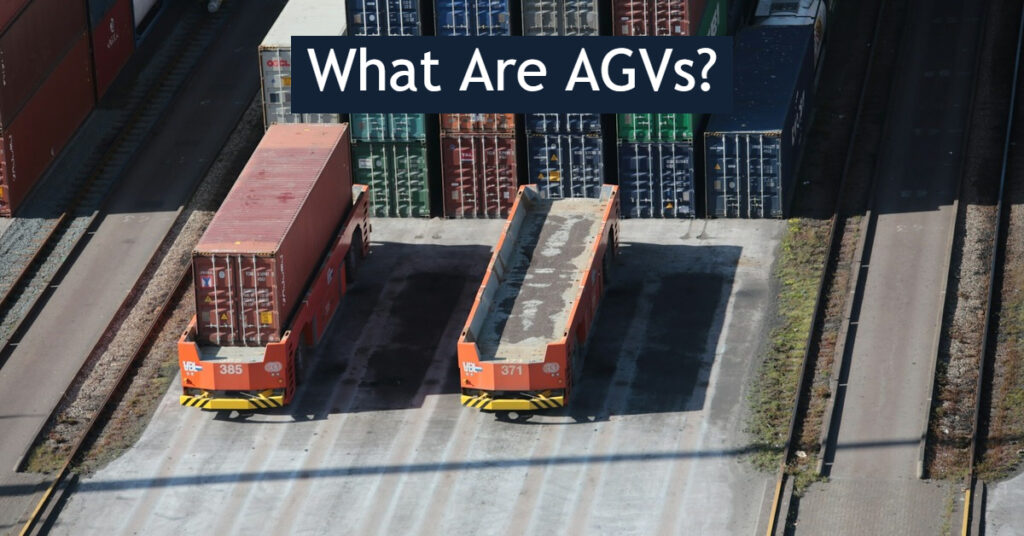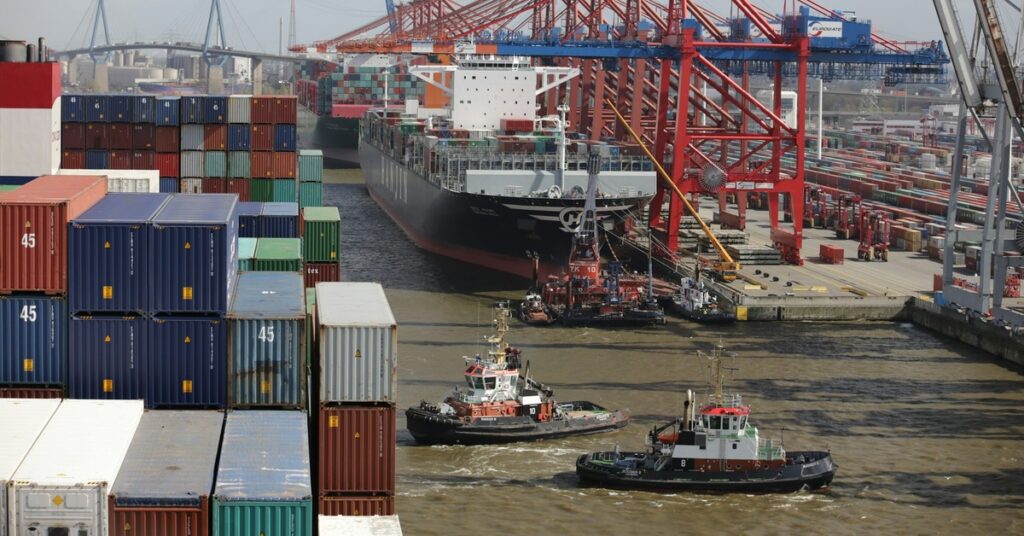Cargo shipping is one of the most critical services in the maritime industry. It is a lucrative business, yet it does come at the expense of time and labor. Automated guided vehicles can minimize the troubles of manual operations and enhance seaport operations. Implementation can take time, but they offer promising results worth the leap.

What Are Automated Guided Vehicles?
Automated guided vehicles — or AGVs for short — are programmed vehicles typically seen in warehousing and distribution. Developers upload a route and motion to give the machinery repetitive tasks.
They were introduced back in the 1950s and were less impressive than now. The machinery was guided by a visible wire, capable of only the towing action.
With technological advancements, automated guided vehicles have grown to be more versatile and capable of different retrieval and transportation methods. Their integration into industrial facilities has heightened efficiency, with the AGV market expected to reach $4.09 billion by 2029. Its presence in seaports is intended to generate the same level of impact.
How Unique are AGVs?
AGVs are viewed as wireless carriers, but they have a hidden sensor connected to a series of wires underneath the ground to trigger motion. More advanced versions of this technology connect to a computer system operators can utilize for rerouting and monitoring. Some are also engineered with laser emitters for advanced piloting.
AGVs are not to be confused with other vehicle calibrations. Some may confuse them with advanced driver-assistance systems, but the standard AGV can still function while well away from the proximity of its operator.
Others may mistake AGVs for autonomous vehicles, but they are quite different. An AGV has a fixed path programmed into it. Self-driving vehicles are more versatile due to their mapping capabilities. Due to such limitations, the former is not equipped for on-the-road driving.
An AGV may also be compared to an autonomous mobile robot (AMR), but they aren’t entirely alike. Similar to a self-driving vehicle, an AMR can still adjust its routes due to its navigation capabilities. The former is more predictable unless equipped with sensors and applications.
Types of AGVs in Seaports
AGVs are a general term for various machinery seaport managers and workers can operate through automated systems. Multiple AGV types are changing the industry.
Towing AGVs
Towing AGVs are responsible for pilling different material handling carts within a facility. Much like regular towing vehicles, they are meant to connect multiple loads of components and products for single transport instead of several one-way trips.
Towing machinery is flexible for supply chain seaports that move various goods at once. It currently has the bulk of AGV’s market share in 2022. Aside from its presence in the maritime industry, it also garners the attention of manufacturers and warehouse managers.
Forklift AGVs
Forklift AGVs can lift and carry loads from seaports to ships and vice versa. Their capability of anchoring heavy cargo can minimize accidents and ensure the security of the goods being transported.
Depending on the forklift design, it can carry multiples of the same item. For instance, food and beverage companies can transport crates in no time. Its lifting features can allow loaders to stack them on top of each other on a ship.
Trailer AGVs
AGV trailers are heavy-duty machinery meant to load objects into their carriers and move them from one area of the port to another. Compared to a forklift AGV, these are engineered to handle a big payload and focus more on carrying than lifting.
These trailers usually have a longer body similar to a truck. This surface area can accommodate a variety of crates in one go. Use it in tandem with an automated forklift for seamless loading and unloading.
Applications in Seaports
AGVs are quite straightforward to use, influencing several cargo shipping processes in seaports. Some brands may utilize all aspects, while others only partially incorporate it.
Cargo Handling
One of the main benefits of using AGVs is they can provide full control over cargo handling. Containers are heavy, which can increase the risk of accidents for seaport workers. The machinery can minimize extreme labor and enhance safety.
Better cargo handling can also improve the security of the load. Tampering and theft are a growing problem in the supply chain, making ports a prime target. As AGVs lessen human contact, they deter thieves from obtaining the goods going into ships.
Loading and Unloading
AGVs are extremely efficient at moving cargo at a seaport. In 2021, the United States ranked last in loading and unloading ship containers from ports, with a median time of 1.25 days. Japan was first at 0.36 days while Taiwan was second at 0.57 days.
Prepping ships and getting them ready for departure takes a lot of time, and relaying sources for moving containers is even more challenging. Luckily, AGVs are automated with fixed paths, speeding up the time spent in the port and enabling multitasking.

Impact on Port Operations
Automation’s versatility has a substantial impact on port operations. AGVs are a game changer for fast-tracking and securing loading and unloading.
Reduced Turnaround
Increased efficiency has always been an objective in ports, especially those with more traffic. A reduced turnaround means sending out or welcoming more vessels into the rotation. AGVs can contribute to this figure.
Towing and forklift AGVs are exceptional for transportation, but designs like the mother-daughter cart system also deserve recognition. Being able to accommodate smaller carts within a larger frame is expected to lower traffic by 70% or so.
Improved Safety
Seaports can become relatively slippery, which is always a disaster when dealing with heavy containers. AGVs are key to improving safety, as they take on the challenging tasks of moving cargo. Loaders can focus on container organization without fear.
Automated vessels can improve safety levels even more if they are optimized with cameras and sensors. Such additions can reduce the probability of accidents since they can detect and prevent collisions from occurring.
Enhanced Sustainability
As climate change continues to plague the world, every industry is called to minimize its environmental impact. AGVs can safeguard cargo to ensure no product goes to waste. It transports it to ship safely, keeping it out of the ocean.
Longer shipping operations can tax resources. Automated systems like these can speed up ship operations, which can lessen fuel consumption and emissions in the long run. All that’s necessary is an efficient scheduling system to minimize unnecessary trips.
Challenges to AGV Implementation
As effective as AGV systems are, they aren’t widespread across ports yet. The main reason may be infrastructure requirements. Automated vessels require plenty of installation, especially when following a wire-based method. Establishments may also be unsure how to utilize these with existing manual machinery, which may still hold up in traditional port operations.
There’s also the expertise required to handle AGV components and program routes. While they have a high payoff, some may refuse to match the level of investment this technology requires.
Deployment of Automation in Seaports
Automation is growing in seaports slowly but surely. For instance, there’s an automatic identification system to pinpoint the position of other ships for simpler navigation. Automation can simplify several administrative tasks, with blockchain technology streamlining paperwork and obtaining customs clearance.
It’s only a matter of time before automation is fully integrated into ports. In fact, they are expected to deploy more than 370,000 AGVs by 2030 with a CAGR of 26% from 2022. These efforts are meant to solve congestion within these spaces and improve processes.
Recognize the Use of AGVs
Automated guided vehicles are becoming more prominent in seaports, and for good reason. Their versatility and influence on productivity and safety are strong, and their sustainability comes at the best possible time. Eagerly await their implementation in operations or take the initiative to invest in them as early as now.
Frequently Asked Questions
What Are AGVs?
Automated guided vehicles are programmed vehicles seen in warehousing and distribution. They have a fixed path that enables them to transport and load cargo.
Are AGVs Useful?
AGVs are helpful, as they can speed up port operations and heighten safety levels in the area. They also contribute to sustainability within the maritime industry.
What Kind of AGVs Are There?
There are models specifically configured for various tasks. For instance, towing AGVs are meant to move multiple materials in one trip while forklift AGVs can lift cargo for organization.
Why Aren’t AGVs Utilized More?
There are several challenges to its implementation, like infrastructure requirements and integration with existing systems. AGVs are getting traction, but they require more recognition.
Are AGVs Viable to Deploy?
Yes, AGVs are viable to deploy due to reduced turnaround time, better safety, and sustainability. Automation is already becoming more prominent in seaports, and such vessels are promising.
- The 15 Most Exciting New Ships of 2025 – January 6, 2025
- How Old Do You Have to Be to Drive a Boat? – November 12, 2024
- The Engineering Behind Ice-Class Vessels – September 20, 2024



